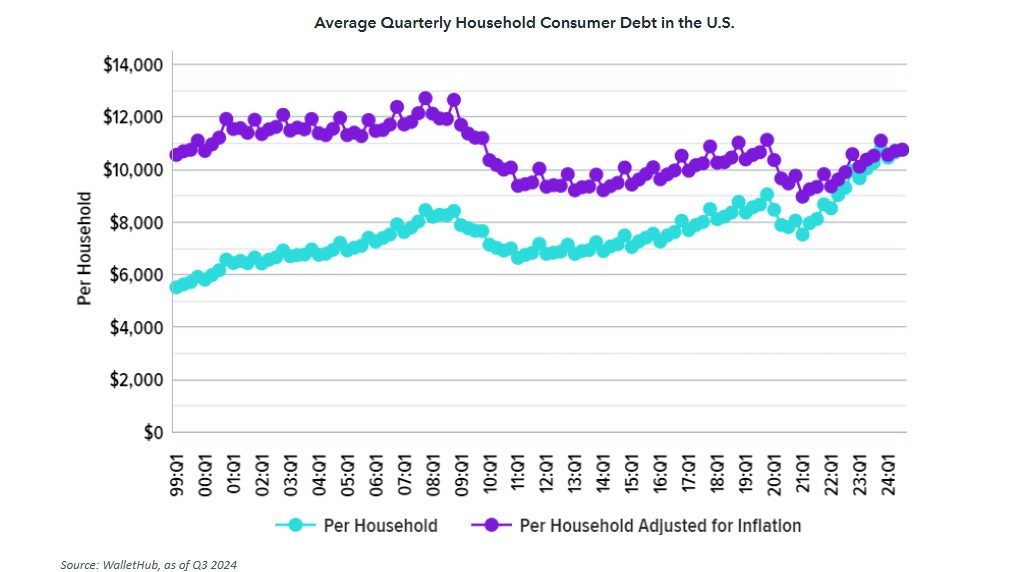Market Commentary | January 21st, 2025
Week in Review…
Major market indices concluded the week with positive returns, while the Treasury yield began its descent from its historical uptrend. A drop in the Treasury yield typically indicates heightened demand for safer investments, often reflecting investor concerns about economic growth or market volatility.
- The S&P 500 closed up 2.91%
- The Dow Jones Industrial Average was higher, up 3.69%
- The tech-heavy Nasdaq rose, up 2.85%
- The 10-Year Treasury yield concluded at 4.62%

Last week we received three key reports—Producer Price Index (PPI), Consumer Price Index (CPI), and retail sales— which provided insights into inflation and consumer behavior.
The week began with the release of the PPI on Tuesday, which showed a 3.3% increase year-over-year for 2024. Notably, PPI inflation has been accelerating, running at an annualized rate above 3% over the past three months. While the PPI measures price changes at the producer level, it doesn’t directly capture the inflation consumers experience at stores and restaurants. For that, markets turned to Wednesday’s CPI release.
The CPI report was the highlight of the week. Core CPI, which excludes volatile food and energy prices, rose 0.2% month-over-month, below the 0.3% estimate. On an annual basis, core inflation rose to 3.2%, also under the forecasted 3.3%. This softer-than-expected inflation data sparked optimism in financial markets, with the major indices recording their best daily performance since November. The bond market also rallied, with the 10-year Treasury yield dropping by 15 bps from the day prior. Investors interpreted the report as a sign that inflation pressures may be easing, increasing the likelihood that the Federal Reserve could hold off on further interest rate hikes.
Thursday’s retail sales report showed a 0.4% increase in December, slightly below expectations. However, the data still pointed to resilient consumer spending, suggesting that holiday shopping remained robust despite higher interest rates. This resilience provides a key support for the broader economy as consumer spending accounts for nearly 70% of gross domestic product (GDP).
Spotlight

The Financial Fallout of Revenge Buying: A Deep Dive into Consumer Debt
Revenge buying refers to the surge in consumer spending that occurs after a period of restricted shopping opportunities, such as during lockdowns or economic downturns. This phenomenon was notably observed after the COVID-19 pandemic, when people, eager to make up for lost time, began splurging on luxury items and non-essential goods.
While revenge buying can provide a temporary boost to the economy, it often leads to significant financial challenges for consumers. Many individuals turn to credit cards to fund their purchases, resulting in mounting debt. According to The Wall Street Times, the total amount owed for credit card debt in the U.S. is surpassing $1 trillion. This surge in debt is exacerbated by high interest rates, making it increasingly difficult for consumers to manage their finances.

The consequences of this trend are severe. Defaults on credit card payments have skyrocketed, with many Americans struggling to keep up with their monthly bills. As stated by WalletHub, the average household credit card debt is now over $10,000, putting immense pressure on families and individuals. High-income households may be able to weather this storm, but lower-income consumers are particularly vulnerable, often finding themselves with zero savings and high levels of financial stress.
Consumer spending is a critical driver of the U.S. economy, accounting for nearly 70% of the GDP, according to The Wall Street Times. When consumers engage in revenge buying, it can initially boost the stock market, particularly in sectors like retail, technology, and consumer discretionary. Companies in these sectors often see higher revenues and profits, which can lead to increased stock prices.
However, the long-term effects can be more complex. As consumers rack up credit card debt and struggle to make payments, their financial instability can lead to reduced spending in the future. This reduction in consumer spending can negatively impact corporate earnings, causing stock prices to fall. Additionally, high levels of consumer debt can lead to increased defaults, which can create broader economic instability and affect investor confidence.
Investors may also become more cautious, shifting their focus to safer assets like bonds or gold, which can lead to volatility in the stock market. The bond market can be particularly sensitive to changes in consumer spending, as high spending can lead to inflationary pressures, prompting the Federal Reserve to raise interest rates. Higher interest rates can decrease bond prices, as new bonds are issued with higher yields.
While revenge buying reflects a desire to reclaim normalcy and indulge after periods of deprivation, it can lead to significant financial strain. The resulting credit card debt and associated struggles highlight the need for better financial planning and awareness among consumers. The stock market and investing landscape are also affected, with potential short-term gains followed by long-term risks.
Week Ahead…

This week will be a shorter trading week than normal due to the Martin Luther King Jr. Day holiday on Monday, closing the market for the day. Despite this, there are still a few key economic reports to watch. Below are some important topics to monitor throughout the week:
Treasury Auctions: This week, the U.S. Department of Treasury will auction 20-year bonds and 10-year Treasury Inflation-protected Securities (TIPS) notes. The long end of the yield curve is primarily influenced by supply and demand rather than monetary policy. Consequently, long-term inflation expectations play a significant role in determining long-term yields. Additionally, the 10-year TIPS auction will allow markets to assess 10-year breakeven rates, a crucial indicator of inflation expectations that provides insights into future inflation and its potential impact on investment returns.
Housing: On Friday, the National Association of Realtors will release the December Existing Home Sales and the month-over-month percentage change in Existing Home Sales. These reports offer insights into the housing market’s strength and, by extension, the overall economy. The previous report (November 2024) exceeded expectations. Another positive surprise would indicate continued economic and consumer strength, especially considering the headwinds from rising interest rates for 30-year mortgages, which started the month at around 6.69% and ended at approximately 6.91%.
Survey Data: S&P Global will release the Services and Manufacturing Purchasing Managers Index (PMI) on Friday. Both indices are vital indicators of overall economic health and future GDP prospects. However, given the significant contribution of services to U.S. GDP, the performance of the Services PMI will have a greater market impact. The Services PMI did not exceed forecasts in the last report, so markets will be keen to see if this trend continues. Meanwhile, the Manufacturing PMI has been hovering near contractionary territory in recent reports, and markets will be watching to see if conditions improve or worsen.
This content was developed by Cambridge from sources believed to be reliable. This content is provided for informational purposes only and should not be construed or acted upon as individualized investment advice. It should not be considered a recommendation or solicitation. Information is subject to change. Any forward-looking statements are based on assumptions, may not materialize, and are subject to revision without notice. The information in this material is not intended as tax or legal advice.
Investing involves risk. Depending on the different types of investments there may be varying degrees of risk. Socially responsible investing does not guarantee any amount of success. Clients and prospective clients should be prepared to bear investment loss including loss of original principal. Indices mentioned are unmanaged and cannot be invested into directly. Past performance is not a guarantee of future results.
The Dow Jones Industrial Average (DJIA) is a price-weighted index composed of 30 widely traded blue-chip U.S. common stocks. The S&P 500 is a market-cap weighted index composed of the common stocks of 500 leading companies in leading industries of the U.S. economy. The NASDAQ Composite Index is a market-value weighted index of all common stocks listed on the NASDAQ stock exchange.

